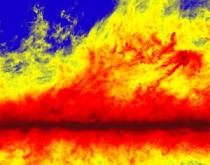#LLL# Filamenti di polvere interstellare a 500 anni luce dal Sole


#LLL# Immagine a falsi colori della polvere
fredda nella Via Lattea. Questa immagine,
ottenuta dallo strumento ad alta
frequenza di Planck (a 857 GHz) copre
una porzione di cielo di circa 55 gradi.
La linea scura orizzontale è la sezione
del piano della nostra galassia. I colori
rappresentano l'intensità dell'emissione
termica della polvere.
The image spans about 50° of the sky. It is a three-colour combination constructed from Planck’s two highest frequency channels (557 and 857 GHz, corresponding to wavelengths of 540 and 350 micrometres), and an image at the shorter wavelength of 100 micrometres made by the IRAS satellite. This combination visualises dust temperature very effectively: red corresponds to temperatures as cold as 10° above absolute zero, and white to those of a few tens of degrees. Overall, the image shows local dust structures within 500 light-years of the Sun.
Planck will scan the entire sky to build the most accurate map ever of the Cosmic Microwave Background (CMB), the relic radiation from the Big Bang. The spacecraft will spin at 1 rotation per minute around an axis offset by about 85° so that the observed sky region will trace a large circle on the sky. As the spin axis follows the Sun the circle observed by the instruments sweeps through the sky at a rate of 1° per day. Planck will take about 6 months to complete a full scan of the sky, allowing the creation of two complete sky maps during the nominal mission lifetime (about 15 months).
The red box shows the region of sky seen in the new Planck image; it covers a portion of the sky about 55°. The background image is a globe representing half the sky as imaged by the IRAS satellite at 100 micrometres.
Filamentary structures are apparent on large scales (as shown in the Planck image, right) and small scales (as seen in the Herschel image of a region in the Aquila constellation, left) in the Milky Way. The Planck image, covering a portion of the sky about 55°, was obtained by the High Frequency Instrument at a frequency of 857 GHz (corresponding to a wavelength of 350 micrometres). The dark horizontal band is the plane of our Galaxy, seen in cross-section from our vantage point. The colours represent the intensity of heat radiation by dust. The Planck image was obtained during the First Planck All-Sky Survey, which began in mid-August 2009 and is being completed now. By mid-March 2010, 98% of the sky had been observed by Planck, and 100% sky coverage is expected by late May 2010.
